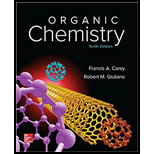
ORGANIC CHEMISTRY (LOOSELEAF)-PACKAGE
10th Edition
ISBN: 9781260008562
Author: Carey
Publisher: MCG
expand_more
expand_more
format_list_bulleted
Concept explainers
Question
Chapter 16.10, Problem 12P
Interpretation Introduction
Interpretation:
The number of deuterium atoms that are expected to be attached to the dihydropyridine ring of NADH following enzymatic oxidation of each of the given isotopically labeled alcohols is to be determined.
Concept Introduction:
Isotopic labeling with deuterium helps in determining the mechanism of a reaction in which a proton is transferred from the reactant to the reagent.
Isotopic labeling can be used to determine a reaction mechanism on the basis of whether the deuterium atom is retained in the product or is transferred to the reagent.
Expert Solution & Answer
Want to see the full answer?
Check out a sample textbook solution
Students have asked these similar questions
Synthesize 1,4-dibromobenzene from acetanilide (N-phenylacetamide) using the necessary organic or inorganic reagents. Draw the structures of the compounds.
Indicate the products obtained by mixing (3-oxo-3-phenylpropyl)triphenylphosphonium bromide with sodium hydride.
We mix N-ethyl-2-hexanamine with excess methyl iodide and followed by heating with aqueous Ag2O. Indicate the major products obtained.
Chapter 16 Solutions
ORGANIC CHEMISTRY (LOOSELEAF)-PACKAGE
Ch. 16.2 - Prob. 1PCh. 16.2 - Prob. 2PCh. 16.4 - Prob. 3PCh. 16.5 - Prob. 4PCh. 16.5 - Give the structures, including stereochemistry,...Ch. 16.5 - Prob. 6PCh. 16.7 - Prob. 7PCh. 16.8 - Prob. 8PCh. 16.8 - Prob. 9PCh. 16.9 - Predict the principal organic product of each of...
Ch. 16.9 - Prob. 11PCh. 16.10 - Prob. 12PCh. 16.11 - Prob. 13PCh. 16.12 - Prob. 14PCh. 16.12 - Prob. 15PCh. 16 - Write chemical equations, showing all necessary...Ch. 16 - Write chemical equations, showing all necessary...Ch. 16 - Which of the isomeric C5H12O alcohols can be...Ch. 16 - Prob. 19PCh. 16 - Write equations showing how 1-phenylethanol could...Ch. 16 - Write equations showing how 2-phenylethanol could...Ch. 16 - Prob. 22PCh. 16 - Show how each of the following compounds can be...Ch. 16 - Prob. 24PCh. 16 - Write the structure of the principal organic...Ch. 16 - Prob. 26PCh. 16 - Prob. 27PCh. 16 - Prob. 28PCh. 16 - Prob. 29PCh. 16 - Prob. 30PCh. 16 - (a) The cis isomer of 3-hexen-1-ol...Ch. 16 - Prob. 32PCh. 16 - Complete each of the following equations by...Ch. 16 - Prob. 34PCh. 16 - Prob. 35PCh. 16 - A diol (C8H18O2) does not react with periodic...Ch. 16 - Identify the compound C8H10O on the basis of its...Ch. 16 - dentify each of the following C4H10O isomers on...Ch. 16 - Prob. 39PCh. 16 - A compound C6H14O has the spectrum shown in Figure...Ch. 16 - Prob. 41DSPCh. 16 - Prob. 42DSPCh. 16 - Prob. 43DSPCh. 16 - Prob. 44DSPCh. 16 - Prob. 45DSPCh. 16 - Prob. 46DSPCh. 16 - Prob. 47DSP
Knowledge Booster
Learn more about
Need a deep-dive on the concept behind this application? Look no further. Learn more about this topic, chemistry and related others by exploring similar questions and additional content below.Similar questions
- Indicate the products obtained by mixing acetophenone with iodine and NaOH.arrow_forwardIndicate the products obtained by mixing 2-Propanone and ethyllithium and performing a subsequent acid hydrolysis.arrow_forwardIndicate the products obtained if (E)-2-butenal and 3-oxo-butanenitrile are mixed with sodium ethoxide in ethanol.arrow_forward
- Question 3 (4 points), Draw a full arrow-pushing mechanism for the following reaction Please draw all structures clearly. Note that this intramolecular cyclization is analogous to the mechanism for halohydrin formation. COH Br + HBr Brarrow_forwardIndicate the products obtained if 2,2-dimethylpropanal and acetaldehyde are mixed with sodium ethoxide in ethanol.arrow_forwardIndicate the products obtained if 2,2-dimethylpropanal and acetaldehyde are reacted with sodium ethoxide in ethanol.arrow_forward
- 2,2-Dimethylpropanal and acetaldehyde are reacted with sodium ethoxide in ethanol. Indicate the products obtained.arrow_forwardAdd conditions above and below the arrow that turn the reactant below into the product below in a single transformationADS fint anditions 百 Abl res condinese NC ง Add on condtions 1.0 B H,N.arrow_forward3. Provide all the steps and reagents for this synthesis. OHarrow_forward
arrow_back_ios
SEE MORE QUESTIONS
arrow_forward_ios
Recommended textbooks for you
 Introduction to General, Organic and BiochemistryChemistryISBN:9781285869759Author:Frederick A. Bettelheim, William H. Brown, Mary K. Campbell, Shawn O. Farrell, Omar TorresPublisher:Cengage Learning
Introduction to General, Organic and BiochemistryChemistryISBN:9781285869759Author:Frederick A. Bettelheim, William H. Brown, Mary K. Campbell, Shawn O. Farrell, Omar TorresPublisher:Cengage Learning Organic ChemistryChemistryISBN:9781305580350Author:William H. Brown, Brent L. Iverson, Eric Anslyn, Christopher S. FootePublisher:Cengage Learning
Organic ChemistryChemistryISBN:9781305580350Author:William H. Brown, Brent L. Iverson, Eric Anslyn, Christopher S. FootePublisher:Cengage Learning Chemistry for Today: General, Organic, and Bioche...ChemistryISBN:9781305960060Author:Spencer L. Seager, Michael R. Slabaugh, Maren S. HansenPublisher:Cengage Learning
Chemistry for Today: General, Organic, and Bioche...ChemistryISBN:9781305960060Author:Spencer L. Seager, Michael R. Slabaugh, Maren S. HansenPublisher:Cengage Learning


Introduction to General, Organic and Biochemistry
Chemistry
ISBN:9781285869759
Author:Frederick A. Bettelheim, William H. Brown, Mary K. Campbell, Shawn O. Farrell, Omar Torres
Publisher:Cengage Learning

Organic Chemistry
Chemistry
ISBN:9781305580350
Author:William H. Brown, Brent L. Iverson, Eric Anslyn, Christopher S. Foote
Publisher:Cengage Learning

Chemistry for Today: General, Organic, and Bioche...
Chemistry
ISBN:9781305960060
Author:Spencer L. Seager, Michael R. Slabaugh, Maren S. Hansen
Publisher:Cengage Learning


